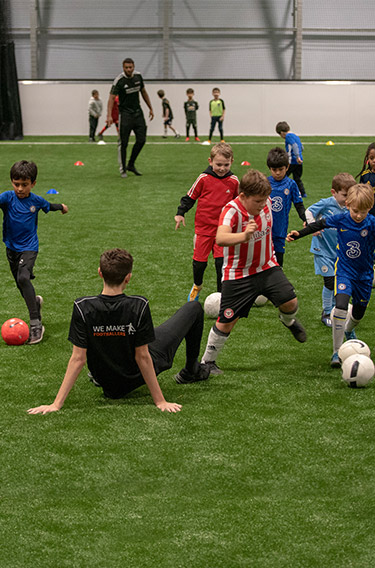As children enter their teenage years, they become increasingly aware of the world around them, the people they’re sharing it with, and new challenges arise. Such awareness isn’t just restricted to everyday life but translates to the football pitch as well.
The age of 12 is the perfect point to learn new skills. Before reaching double figures, most children dream of becoming the next Cristiano Ronaldo or Lionel Messi, dribbling past defenders and scoring great goals. Yet, by the time they’re 12 years old, they’ll be developing a greater understanding about the importance of working as a team, their playing style and formation, especially if they are playing games or joined a grassroots team. They’ll also have the necessary core skills to begin attempting some advanced technical and physical exercises.
Although players will sometimes face changes in the physical, psychological, technical and social corners of football over their years, it’s vitally important that they are in a positive footballing environment which can fully aid their development.
The age of 12 is an important milestone in a child’s footballing journey and there are some core skills that can help them become more accomplished, technically gifted players.
MASTER THE BALL WITH KEEP-UPS
Keep-ups or Kick-ups focus on the player’s technical ability which will tie into their confidence on with the ball. Manipulating the ball using all parts of the foot is one of the first skills that can be taught to children when they begin playing football, no matter their age.
The next step can come through teaching them to do keep-ups. This will encourage them to use other parts of their bodies such as the thigh or chest and gain closer control of the ball through the need to keep-the ball near.
Keep-ups may seem like a simple skill to include in this blog, but footballers of all ages and abilities practice them throughout their journey– take a look at Maradona practising this skill before a game.
This exercise can be turned into a competitive challenge makes them a particularly useful way of improving ball control. Children love having targets to beat as it becomes a game instead of practice. Attempting to set a record for the number they can do gives them something to aim at.
With freestyle football skills becoming increasingly popular amongst younger generations – Billy Wingrove and Jeremy Lynch are freestylers with over 3 million followers on Instagram and over 4 million subscribers on YouTube for example. Keep-ups are a great and fashionable way to increase 12-year-old’s ball skills.
PASSING AND MOVING
Players should be encouraged to work on their passing skills from a young age. Once they’ve developed the basics of how to pass the ball with the correct part of their foot, the different variations of passes in football, seeing a teammate they can pass to and successfully giving them the ball, then they can move onto the next stage which is passing and moving.
At 12 years old, children are improving their special awareness, game understanding and the ability to think ahead. They can begin to concentrate on playing a pass as well as anticipating what comes next. Introducing passing and moving practices or combined with team games will help players to pass effectively and then get into the best position to receive the ball back.
The one-two is a highly effective weapon in a team’s armoury for keeping possession and moving the ball down the pitch. It also improves a player’s awareness, movement and their appreciation of their teammates’ roles.
LEARNING ABOUT THE IMPORTANCE OF SHAPE IN FOOTBALL
When playing matches in their early years, children tend to just want to be where the ball is. The idea of a formation or shape is pretty much alien to them. With players aged 12, shape becomes more relevant can play an important role in their development as they start to work on the concept and learn more about positions in football.
As they play, they will be learning how different formations work and what the advantages of each system are. Positional discipline will come with this, as will the decision-making process that helps them to know when a full back should be running forward or holding their position.
Playing in different formations feeds into being taught about patterns of play, such as a midfield three working together in triangles to move the ball quickly and effectively across the pitch.
PRACTISE MAKES PERFECT
Although learning and practising these skills might seem somewhat idealistic, these are skills that players of all abilities can work on and will face in their football journey.
The environment in which a player learns is fundamental. We Make Footballers offer professional football coaching welcoming players of all abilities.
To see if our training can help you to develop physically, psychologically, technically and socially as a player, book a free trial at your closest centre.



